
This page last modified: 2 July 2015 (AE 1944,0068 reference added)

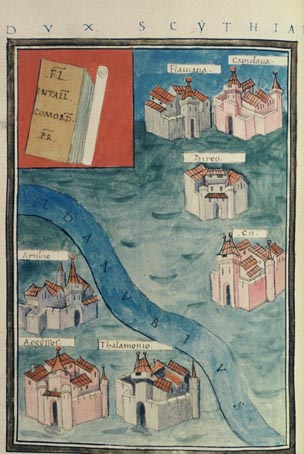 Above: Frontpiece from the Bodleian manuscript. The stations depicted are: Flaviana, Capidava, Bireo, Cii, Arubio, Aegissos, Thalamonio. Note that in reality, all these locations are on the right bank (south side) of the Danube. |
The following (cavalry units or detachments of units) are listed as being under the command of the Duke of Scythia (i.e. southeast Romania; the numbers in front of the names refer to Ingo Maier's numbering scheme):
74.2 Cuneus equitum scutariorum, at Sacidava along with the following Auxiliares units (or detachments of units):
74.10 Milites navclarii, at Flaviana and the following (prefects and their) riparian legionary units (i.e. legionary units stationed along the riverine frontier):
74.19 Praefectus legionis secundae Herculiae, at Trosmis |
None of the shield patterns for these units are recorded. Note that Seeck amended (OR. XXXIX.31) the Praefectus legionis Herculiae cohortis quintae pedaturae inferioris to read Praefectus ripae legionis secundae Herculiae cohortis quintae pedaturae inferioris.
Legio I Iovia, or, as attested epigraphically, Legio I Iovia Scythica (e.g. AE 1944,0068, a tile from modern Garvan in Romania, bearing the legend LEGIO I IOVIAE SCY; see also The Tetrarchic Reorganization of the Limes Scythicus, Mihail Zahariade; The Lower Danube in Antiquity, International Archaeological Conference, Bulgaria-Tutrakan 6-7.10.2005; Bulgarian Academy of Sciences, National Institute of Archaeology and Museum, Sofia, 2006; p 1-12, available here) was an early Tetrarchic creation, along with the co-located Legio II Herculia, established to defend the newly-organised province of Scythia. It may have been the parent unit of the Scythae under the Magister Militum Praesentalis II.
It is possible the men under the Praefectus alae Herculeae, under the command of the Comes Tingitaniae is a detachment of Legio II Herculia; see his entry for details. In addition to inscriptional evidence from far-off North Africa, men from Legio II Herculia are also attested in inscriptions from Kherson in the southern Ukraine: AE 1984,808 gives LE[...] ITAL ET [...]RCVLIA , which expands to "legiones I Italica et II Herculia"; while AE 1994,1539 gives VIXI[...]ONIS LE[...] ITAL ET [...]RCVLIA, which expands to "v[e]xillationis legionis I Italicae et legionis II Herculiae".
Note that in the Bodleian frontpiece shown above, Flaviana is shown as the first fort illustrated, instead of the expected Sacidava. This is also the case in illustrations shown in the other manuscripts: below are shown the frontpieces from the Parisian manuscript, P; and the Froben printed edition, B:
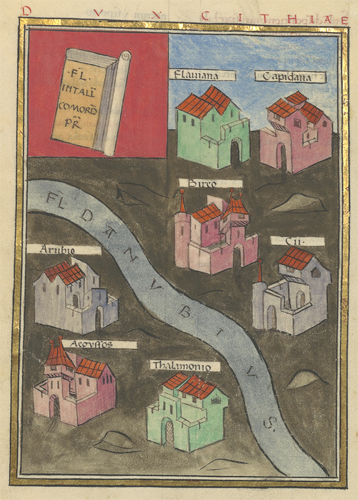
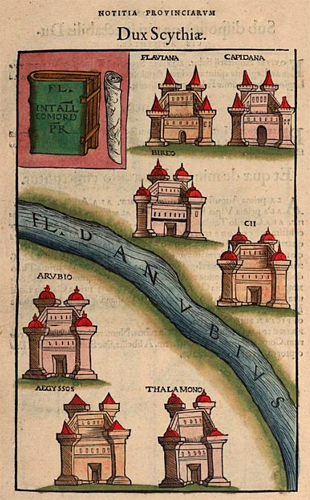
And below are shown the frontpieces from the first set of pictures in the Munich manuscript, M; and the second set, W.
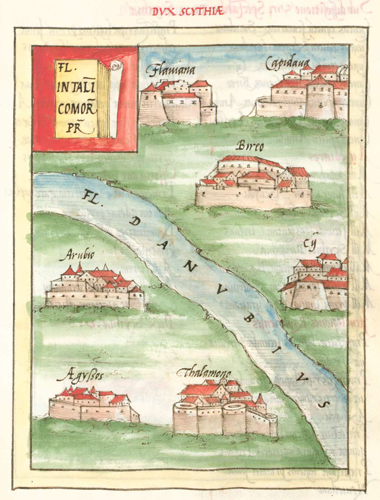
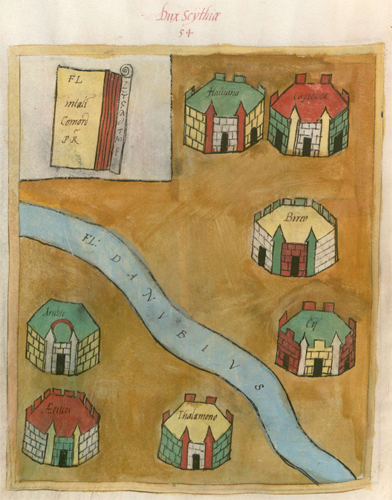
It would appear the first of the auxiliary stations has been used as the fort's label instead of the first of the cavalry stations; this may have been a mistake introduced into e.g. the Carolingian intermediate copy of the Notitia, or it may have been present in the original compilation. Note that a Sucidava is listed under the Dux Moesiae secundae; this is not the same locality as Sacidava: Sucidava is modern Corabia in Romania, on the left (northern) bank of the Danube, while Sacidava lies ca. 300 km to the east (modern Rasova), and is on the right (southern) bank.

Return to the Notitia index page.